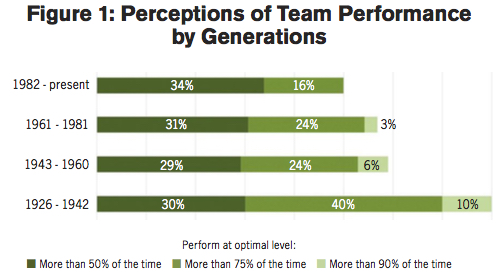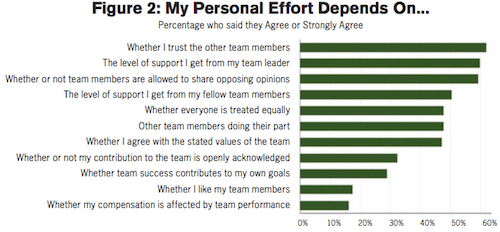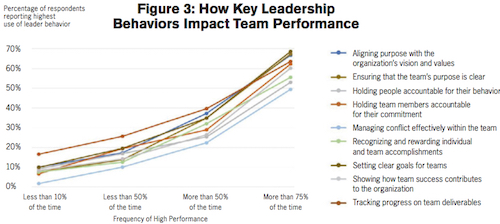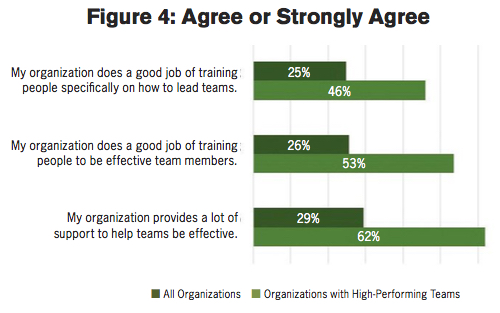
The nature of teamwork in today’s organizations is evolving. New research conducted by Training magazine and The Ken Blanchard Companies polled 1,300 employees and managers and found that while people spend more than half of their time working in teams, significant gaps exist between what people want and what they are experiencing in terms of clarity, accountability, and leadership practices.
The survey identified a perceived lack of accountability among team members as the No. 1 obstacle to team performance. Respondents also identified trust in other team members as the No. 1 factor in determining the amount of effort they put into a team.
The survey found significant gaps between the amount of support high-performing teams receive and the support average teams receive—at both an individual leader and organizational level. With today’s accelerated pace, teams don’t have as much time to form, experiment, and organically develop along the way. This leaves an opportunity for Training and Development professionals to review the state of teams in their organizations and take steps to close the gaps.
PERCEIVED LEVELS OF PERFORMANCE—SOME GENERATIONAL DIFFERENCES
As a part of the survey, respondents were asked how often teams perform at optimum levels in their organizations. Overall, only 27 percent of respondents said their teams perform at top levels a majority of the time, while 43 percent said their teams operate at optimum levels less than half the time.
The survey uncovered some generational differences in perceptions, with team performance being rated higher by older respondents than by younger respondents. Respondents born in 1942 or earlier scored their team experiences the highest, while people born from 1942 to 1960 or from 1961 to 1981 evaluated their team performance at lower levels.
Millennials (people born after 1982) experienced the largest gap between expected and actual team performance. Only 50 percent of Millennials said their teams perform at an optimum level more than half of the time, and only 16 percent said their teams operate at optimum levels a majority of the time.
See Figure 1 for the generational breakdown.

PERSONAL EFFORT CONSIDERATIONS
Respondents also were asked to identify what conditions impact the level of effort they put into the teams they work on. Eleven different conditions were listed, and respondents were asked the extent to which they agreed or disagreed with each statement (see Figure 2).

When asked, “As a member of a team, the amount of effort I contribute to a team depends on…,” the top three statements respondents most agreed with were:
- Whether I trust the other team members
- The level of support I get from my team leader
- Whether or not team members are allowed to share opposing opinions and disagree with each other
The three statements respondents deemed least important were:
- Whether team success contributes to my own goals
- Whether I like my team members
- Whether my compensation is affected by team performance
THE TEAM LEADER’S ROLE
An expanded analysis of the survey results correlated leadership behaviors with team performance. A total of nine key leadership behaviors were studied. Nearly 90 percent of respondents indicated that these leadership behaviors were critical or very important to how teams function:
- Aligning purpose with the organization’s vision and values
- Ensuring that the team’s purpose is clear
- Holding people accountable for their behavior
- Holding team members accountable for their commitment
- Managing conflict effectively with in the team
- Recognizing and rewarding individual and team accomplishments
- Setting clear goals for teams
- Showing how team success contributes to the organization
- Tracking progress on team deliverables The more that respondents observed positive leadership behaviors, the more likely the team was to be high performing.

THE IMPORTANCE OF TRAINING
Another section of the survey looked to correlate perceived training and support with team performance. The survey found that the highest-performing teams enjoy greater levels of support in general, as well as higher levels of training for both team members and team leaders.
For example, when asked to what degree their organization supported teams to help them be more effective, 62 percent of people in organizations with high-performing teams agreed or strongly agreed that their organization provides a lot of support—a full 33 points higher than the overall average of 29 percent.
When respondents were polled specifically about the level of training team members and team leaders receive, organizations with high-performing teams outpaced average ones 53 percent to 26 percent when it comes to doing a good job with team member training. And organizations with high-performing teams outpaced average ones 46 percent versus 25 percent when it comes to doing a good job training people specifically on how to lead teams (see Figure 4).

TAKING ACTION: START WITH A QUICK ASSESSMENT
For organizations looking to improve team training to meet increasing needs, Dr. Eunice Parisi-Carew, founding partner and researcher with The Ken Blanchard Companies, recommends leaders begin with a seven-point checklist to identify areas where teams might not be performing at optimal levels.
“In the absence of data, there is a tendency for leaders to overestimate the effectiveness of their teams,” says Parisi-Carew. “So it’s important for senior leaders to first get an accurate picture of what is happening in their organizations. For example, the Blanchard/Training magazine survey identified a 15 percent gap in the way executive-level leaders and individual contributors see team performance levels. For executive leaders, 35 percent say high performance is more frequent, while only 20 percent of individual contributors see the same frequency of high performance.
Here are the seven key areas Parisi-Carew suggests leaders explore as a starting point.
1. Purpose and values. Does the team share a strong sense of purpose and a common set of values? Does the team have an agreed-upon compelling vision? “All good team performance starts with clear goals,” explains Parisi-Carew.
2. Empowerment. Do team members have authority to act and make decisions? Does the team have clear guidelines about what is and isn’t out of bounds?
3. Relationships and communication. Is the team committed to open communication? Do people feel they can take risks and share their thoughts, opinions, and feelings without fear? “It is critical that team members communicate openly and honestly and demonstrate respect for others,” shares Parisi-Carew.
4. Flexibility. Do team members feel a shared responsibility for team performance, development, and leadership? How does the team adapt to changing conditions?
5. Optimal productivity. Is the team committed to high standards and quality? Do team members hold each other accountable and strive for continual improvement?
6. Recognition and appreciation. Do team members provide each other with positive feedback and recognition? “Recognition reinforces behavior, builds esteem, and enhances a feeling of value and accomplishment,” says Parisi-Carew.
7. Morale. Are team members enthusiastic about their work? Are they proud of their results and of belonging to the team?
MODEL THE BEHAVIOR
For organizations ready to begin improving their teams, Parisi-Carew suggests Training and Development professionals be proactive and model an inclusive learning attitude. “Involve others in crafting a clear purpose, as well as values and goals for your teams. Have leaders follow through by reinforcing what was agreed upon, demonstrating supportive behaviors, and walking the talk,” she explains.
“Talk openly,” she adds. “Create an environment of safety and trust where people are comfortable speaking out about improving team performance without worrying about upsetting the status quo.
“Take action. Some leaders need to learn how to let go. Don’t wait for someone else to decide it’s time to collaborate— everyone is responsible for creating a collaborative environment.”
When people are busy, it’s normal to want to focus on getting individual work done. To combat this urge, Parisi-Carew reminds us of an old adage: “If you want to go quickly, go alone. If you want to go far, go together.” Knowing the characteristics and needs of a high-performing team is critical. The results of the Training magazine/ Blanchard survey provide a snapshot into today’s teams. The survey results give Training and Development professionals a target to shoot for and recommended first steps as they look to create or enhance team training programs in their organizations. Consider how these results and findings can help begin a dialogue about team performance in your organization.
Jim Diehl is a research analyst for The Ken Blanchard Companies and a core member of Blanchard’s research and development team.
David Witt is a program director and researcher for the Office of the Future, The Ken Blanchard Companies’ think tank and research and development division.

